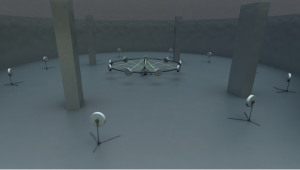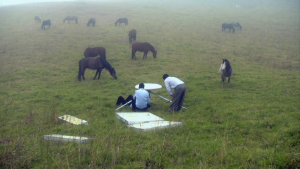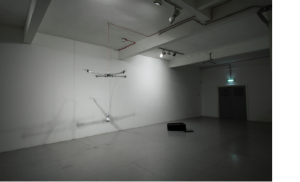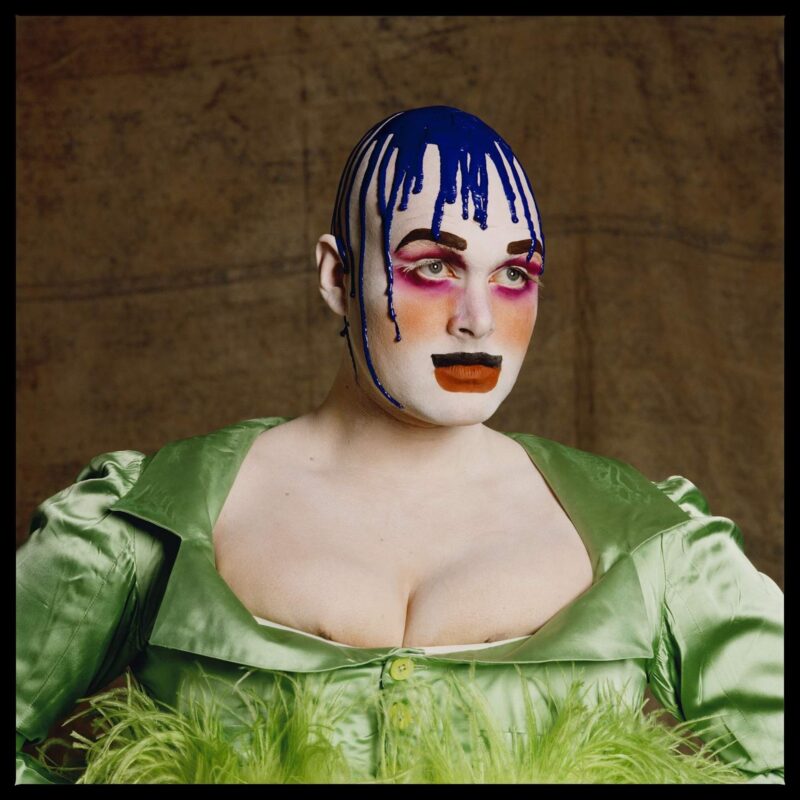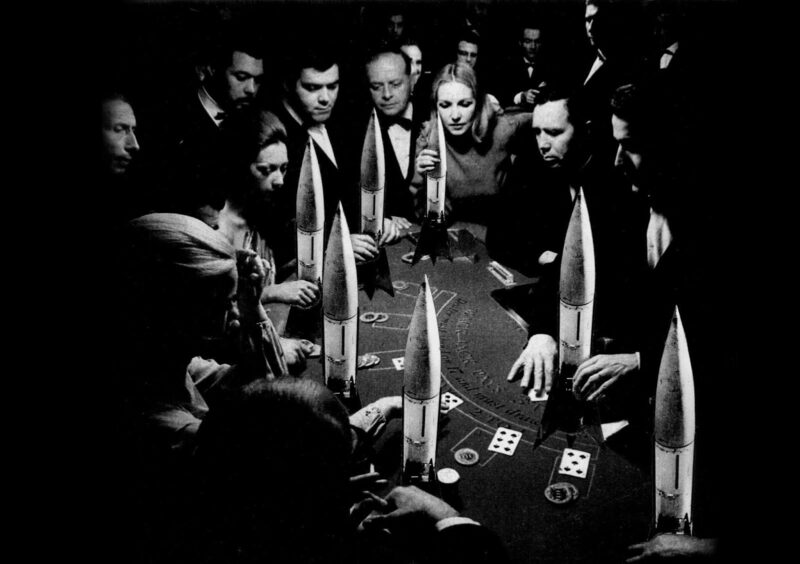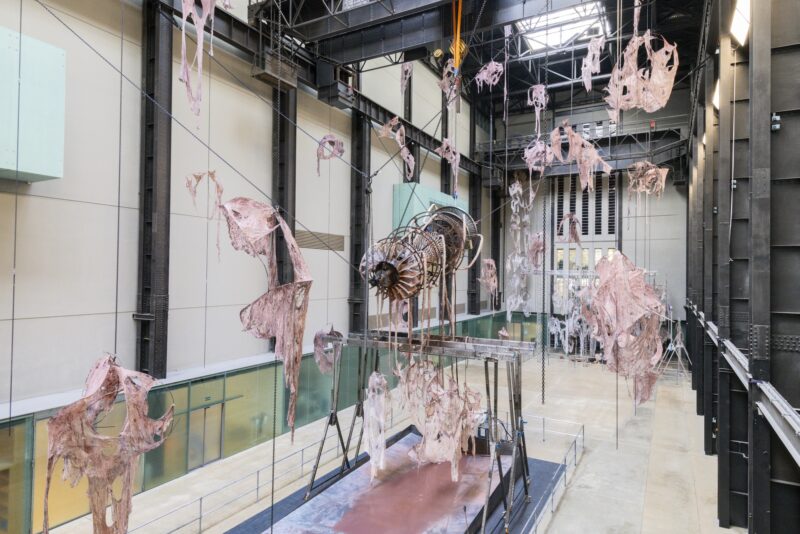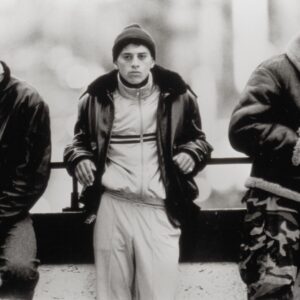Jon Fawcett, Whum, 2012. 6082 aluminium, bright steel, stainless steel, kevlar, polypropylene, motor, undisclosed materials. Seven metre wide, highly engineered device slowly rotating to create a torsional field with an undisclosed nature.
Jon Fawcett, Wheel, 2007. Still of a full HD video (28 minutes). Carbon fibre, 2K paint, cast aluminium tripod, aluminium and steel machine parts, neoprene, cotton gloves, aluminium flight case, foam, transit stickers, Ecuadorian dirt. Three me carry, assemble and operate a device in eight specific locations in the highlands of the Ecuadorian Andes.
Jon Fawcett, Blessor, 2010. Aerospace grade aluminium, carbon fibre propellors, electronics, 2.4 GHz remote control system, explosives, tangerine flavoured icing sugar, stainless steel machine parts, tackle, zip ties, nylon, suitcase, foam. A remote controlled helicopter drone, paralleling military surveillance technology but designed by the artist and using open source electronics, carrying a payload of explosives packed with tangerine flavoured icing sugar. Blessor was demonstrated in Liverpool in 2010, creating a cloud of tangerine flavoured icing sugar at a specific location and time.
16th -17th August 2012
Fawcett’s work is the first in a series of Tate’s Young People’s Programme, which presents Undercurrent. A series of live events, installations and interventions exploring the connections between subcultures, countercultures, and the mainstream.
See: www.tate.org.uk/
What looks like an enormous steel bicycle wheel rotates in front of me. Around its circumference cylindrical pods are attached. Absurd, abstracted presences: their meanings are difficult to place. The pods appear too in the curious, three-legged structures that mark out the space of the wheel. I walk around it and in-between the objects that surround it, searching for a clue. But the more I look the more I think the difficulty of reading these objects, the sensation of distance and remove is part of their point. They invite us to play with the processes of interpretation – wheels, come to think of it, embody ideas about progress, technological advancement, science and engineering.
Wheels are also a ubiquitous, even innocuous presence in everyday life. They have histories both ancient and modern. But they make me think too of the underbelly of progress: war, destruction and catastrophe. Jon Fawcett’s work reminds me of literary and cinematic worlds – from H.G Wells to Stanley Kubrick – unsettling spaces and objects, and atmospheres that are at once deadpan and slightly ridiculous, shape dream-like realities. These appear dystopian, precarious and unknowable while they are absurd.
Titled Whum this installation by Fawcett is shown for the first time at The Tanks. Its title is onomatopoeic, reminding me of the words children give to sounds as they play, or the word-games of Dada. It is 7-metres wide and constructed in collaboration with an engineering team. Whum was developed from Fawcett’s research into pseudosciences produced by Einstein’s Unified Field Theory and the Philadelphia Experiment conspiracy theory (Fawcett explains: ‘the US military are said to have transplanted a battleship from one place to another using Einstein’s unfinished Unified field theory’). Referring to the rotation of the wheel, he talks about the pseudoscience of torsion fields: ‘a spinning field in a static field which creates a kind of folding amplified field’. Fawcett’s work, and his research process, crossing multiple worlds and different logics, invites us to think about how artists are working now – in the 21st century – at the intersections between aesthetic practice, popular knowledge, science and technology. The idea of crossing fields is embedded in the materiality of the work and its making. Industrial substances and military materials often find their ways into Fawcett’s constructions: Blessor (2010) is a helicopter drone incorporating aerospace grade aluminium.
Both Whum and a second installation, EIR – also shown for the first time at Tanks – builds on Fawcett’s interest in worlds that are marginal and at the peripheries of orthodox thought. Video works such as How to be a Superhero (2011) and Flying (2011) re-constitutes found footage from what Fawcett calls the ‘most convincing UFO related conspiracy videos’. His work opens up the ways in which the lines between imagination and myth; ideology and propaganda; rationality and science are not necessarily sharply drawn or even understood.
Fawcett’s installations draw us into experiences – spatial and perceptual – that are disruptive and discomforting, as they are funny. EIR consists of a series of banal booths, built out of MDF. A psychic sits in each of these. We are invited to approach the booth and answer questions drawn from an official looking form – the psychic reads the questions off the form and fills in our responses. Here the borderlines between what we think is fact and what we assume to be fiction blur in ways that are slightly disorientating. The psychics are real but the booths, and our interaction with them, are clearly staged. How we interact with them depends on who we are or who we imagine ourselves to be. And indeed who we imagine them to be. Our capacity for choice determines how we respond to the questions read off the form (which incidentally is litho-printed), and how it is we choose to perform our role as viewer. Each of us will bring different inflections to the discussion mediated by the vocabulary of yes and no answers, and questions about subjects such as spirituality and power. In my own session with one of the psychics, I felt the frustration of the official document with its probing questions and its demand for answers. I also felt the fear of the unknown, the absurdity of the staged encounter and my own performance. Unexpectedly I felt the pleasure of self-reflection, and human interaction.
It was fun, in an off-beat kind of way, to interact with the psychic, to inhabit a space shaped by disparate worlds brought into being by different logics. Fawcett comments: ‘There’s this world and we’re told things about it. We’re educated in certain ways. And then there are lots of people who have other beliefs which go beyond traditional, institutional education. But that doesn’t get talked about. Doesn’t get articulated. I’m interested in articulating this’.
Review by Yvette Greslé
